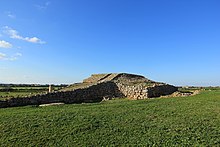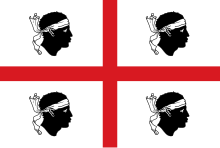Sardinians
As Sardinians refers to the indigenous population of the island of Sardinia in the western Mediterranean , the politically Italy belongs. The inhabitants are called Sardinians and not, as is often assumed, "Sardinians". Due to the changeful history of Sardinia , people from other peoples mixed with the "ethnic Sardinians" who lived on the coasts.
origin


The origin of the Sardinian people remains obscure: the root word "S (a) rd" belongs to an old pre-Indo-European substratum and could have its origin with the Iberians . The oldest written certificate about the ethnonym is on the stele of Nora , where the word Šrdn ( Shardan ) seems to be attested at a time when Phoenician merchants first came to the Sardinian coast.
According to Plato's dialogues Timaeus , the Sardinians (Σαρδονιοί or Σαρδιανοί) could have been named after “Sardò” (Σαρδώ), a legendary Lydian woman from Sardis (Σάρδεις) in the western Anatolia region ( Turkey ). According to other authors, like Pausanias and Sallust , the Sardinians traced their lineage back to the Sardus Pater Babai ( "Sardinian Father" or "Father of the Sardinians'), a mythical ancestor and Libyan son of Hercules or Makeris , either related to the Kabyle Maqqur "He is the greatest" or associated with the character of Melqart .
It has also been claimed that the ancient Nuragic- Sardinians may have been the sea people of the Sherds ( šrdn in ancient Egyptian ). The ethnonym was then romanized as sardus and sarda .
The data seem to suggest that today's population of Sardinia came in large part from the Stone Age settlers and the contribution of the historical colonizers. The latter, however, is only relevant in the coastal areas, as the locals left the malaria-infested (albeit strategically important) lowlands to the foreign powers and fled into the rougher interior, where most of Sardinia's historical settlements were concentrated. The ancient Sardinians were not Italians : some researchers claim that they came from the eastern Mediterranean. Further research suggests that the Basques from Spain may be the genetically closest population to the ethnic Sardinians and that this similarity is not due to the influence of other Spaniards during the modern era.

languages
Italian was first introduced in Sardinia by the House of Savoy in July 1760 and is the most widely spoken language today, albeit in a regional variant, as a result of waves of assimilation and language changes that promoted cultural Italianization .
The Sardinian people number around 1.0 to 1.3 million people and roughly correspond to the speakers of the Sardinian language ( sardu ), which belongs to the Romance language family . The historic loss of political autonomy of the Sardinians has kept their language in a state of dialectal fragmentation as various other languages (namely Catalan , Spanish , and ultimately Italian) asserted themselves in a position of political prestige . The Sardinian language is in decline due to Italian schooling, which has promoted Italian to the detriment of Sardinian. Although the Sardinians make up the majority of the population in Sardinia, most of them are largely culturally Italianized and the bilingual Sardinians have become a small minority on their own island. It is estimated that only 13 percent of young Sardinians today have language proficiency in Sardinian.
A local Catalan dialect is spoken around Alghero , as descendants of Catalan settlers once lived there, and in Arborea in the province of Oristano there is still a group of mainland Italians resettled by Mussolini who speak Furlan and Venetian dialects.
flag
The so-called flag of the Four Moors is the historical flag of the Sardinians. The flag consists of the George Cross and four decapitated heads of the Moors who wear a white headscarf in each quarter. Its origins are largely enigmatic, but it is believed that it originated in Aragon to symbolize the defeat of the Saracen invaders in the 1094 Battle of Alcoraz.
Demographics
In contrast to the other Europeans, the Sardinian ethnic group has a very high percentage of people who are over 100 years old; it is believed that this could be the case for specific genetic as well as social reasons.
See also
literature
- Historia de la isla de Cerdeña, por el caballero G. de Gregory, traducida al castellano por una sociedad literaria. Imprenta de Guardia Nacional, Barcelona, 1840.
- Amiram Gonen: Diccionario de los pueblos del mundo . Ed .: Anaya & Mario Muchnik. 1996.
- Steven Danver (Ed.): Native peoples of the world: An Encyclopedia of Groups, Cultures, and Contemporary Issues. Sharpe Reference, Armonk, 2013, ISBN 9780765682222 .
- Francesco Cesare Casula: La Storia di Sardegna . Ed .: Carlo Delfino Editore. Sassari 1994.
- Manlio Brigaglia, Giuseppina Fois, Laura Galoppini, Attilio Mastino, Antonello Mattone, Guido Melis, Piero Sanna, Giuseppe Tanda: Storia della Sardegna . Ed .: Soter Editore. Sassari 1995.
- Giovanni Ugas: L'Alba dei Nuraghi . Ed .: Fabula Editore. Cagliari 2006, ISBN 978-88-89661-00-0 .
- Jeffrey Cole: Ethnic Groups of Europe: an Encyclopedia . Ed .: ABC-CLIO. 2011, ISBN 978-1-59884-302-6 .
- Ercole Contu: I sardi sono diversi . Ed .: Carlo Delfino Editore. 2014.
- Omar Onnis: La Sardegna ei sardi nel tempo . Ed .: Arkadia Editore. 2015.
- Rolf Ackermann: Sardinia: Far away from the Sardinians. In: Die Zeit 7/1985. February 8, 1985 .
- Albert Richter: From the land of the Sardinians . In: The Gazebo . Issue 29, 1876, pp. 485-487 ( full text [ Wikisource ]).
Individual evidence
- ↑ Lisa Marlene precious Ward, Philip Salzman: Sardinians. In: Encyclopedia of World Cultures , 1996.
- ↑ Jeffrey Cole: Ethnic Groups of Europe: An Encyclopedia . Pp. 321-325
- ↑ Viola Grugni et al .: Y-chromosome and Surname Analyzes for Reconstructing Past Population Structures: The Sardinian Population as a Test Case. In: International Journal of Molecular Sciences . Retrieved November 18, 2019 .
- ↑ a b c Marcello Serra: Enciclopedia della Sardegna: con un saggio introduttivo intitolato Alla scoperta dell'isola . Giardini editori e stampatori, Pisa 1978, p. 29: Origine e carattere dei Sardi
- ↑ Natale Sanna: Sull'origine del popolo sardo le fonti classiche non riescono a darci che poche e scarse notizie, la cui interpretazione non è affatto facile . In: Il cammino dei Sardi: storia, economia, letteratura ed arte di Sardegna , I. Ed.Sardegna, Cagliari 1986, p. 19
- ↑ a b c Sardinia. Online Etymology Dictionary, accessed March 19, 2020 .
- ↑ a b Sardi. In: Dizionario di Storia (2011). Treccani, accessed March 19, 2020 .
- ^ IES Edwards, CJ Gadd, NGL Hammond, E. Sollberger (edited by): The Cambridge Ancient History . Volume II, Part 2. Cambridge University Press, 1970, p. 369
- ↑ Platonis dialogi, scholia in Timaeum (edit. CF Hermann, Lipsia 1877), 25 B, p. 368
- ^ M. Pittau: La Lingua dei Sardi Nuragici e degli Etruschi . Sassari 1981, p. 57
- ^ Emanuele Sanna: Nella preistoria le origini dei sardi . CUEC, Cagliari, 2009, p. 76
- ↑ Francesco Cèsare Casula: La storia di Sardegna, I, Evo Antico Sardo: Dalla Sardegna Medio-Nuragica (100 aCc) alla Sardegna Bizantina (900 dCc) . 2017, p. 92
- ^ Sallust, Historiae , II, fr. 4
- ↑ Pausanias, Ελλάδοσ περιήγησισ, X, 17
- ↑ Silius Italicus , Punica , XII, 360
- ^ Gaius Julius Solinus , Collectanea rerum memorabilium , IV, 1
- ^ Isidore of Seville , XIV, Etymologiae , Thapsumque iacentem , 39
- ^ Attilio Mastino: L'iscrizione latina del restauro del tempio del Sardus Pater ad Antas e la problematica istituzionale. August 27, 2015, accessed March 19, 2020 .
- ↑ E. De Rougè. In: Révue Archéologique , XVI, 1867, p. 35 ff.
- ^ FJ Chabas: Étude sur l'antiquité historique d'après les sources égyptiennes et les monuments réputés préhistoriques . impr. de J. Dejussieu, (Chalon-sur-Saône) 1872, pp. 191-192, 314
- ↑ Giovanni Ugas: Shardana e Sardegna: i popoli del mare, gli alleati del North Africa e la fine dei grandi regni (15th-12th secolo aC) . Edizioni della Torre, Cagliari 2017, pp. 398-408
- ↑ Sardi . In: Enciclopedia Italiana . Giacomo Devoto, Treccani 1936
- ↑ Nuovo studio dell'archeologo Ugas: “È certo, i nuragici erano gli Shardana”
- ↑ Shardana, sardi nuragici: erano lo stesso popolo? Interview with Giovanni Ugas (in Italian)
- ↑ La certezza degli accademici egiziani: “Gli shardana erano i nuragici sardi”. In: SardiniaPost. January 25, 2019, accessed March 19, 2020 (Italian).
- ^ A b Francesco Cucca: "Caratteri immutati da diecimila anni, ecco perché la Sardegna è speciale" (di Elena Dusi) - Sardegna Soprattutto
- ↑ Marcus et al., Population history from the Neolithic to present on the Mediterranean island of Sardinia: An ancient DNA perspective , 2019
- ↑ Ancient DNA from Sardinia reveals 6,000 years of genetic history. In: Science Daily . February 24, 2020, accessed on March 19, 2020 .
- ^ JH Marcus, C. Posth, H. Ringbauer et al .: Genetic history from the Middle Neolithic to present on the Mediterranean island of Sardinia . In: Nature Communication . tape February 11 , 24, 2020 (English, nature.com ).
- ↑ ... "La separazione della Sardegna dal resto del continente, anzi da tutte le altre popolazioni europee, che probabilmente rivela un'origine più antica della sua popolazione, indipendente da quella delle popolazioni italiche e con ascendenze nel Mediterraneo Medio-Orientale." Alberto Piazza, I profili genetici degli italiani , Accademia delle Scienze di Torino
- ^ Genomic history of the Sardinian population , Nature
- ^ Cardia, Amos (2006). S'italianu in Sardìnnia candu, cumenti e poita d'ant impostu: 1720-1848; poderi e lìngua in Sardìnnia in edadi Spanniola , Iskra, Ghilarza, pp. 88, 91
- ↑ Sardinians . In: World Directory of Minorities
- ^ Marius Sala, Rebecca Posner: Sardinian language. In: Encyclopædia Britannica . Retrieved July 31, 2019 .
- ^ Martin Maiden, John Charles Smith, Adam Ledgeway (edited by). The Cambridge History of the Romance Languages: Volume II, Contexts , Cambridge University Press, 2013, p.167
- ↑ La Nuova Sardegna, 04/11/10, by salvare i segni dell'identità - di Paolo Coretti
- ↑ Luciano Piras: Silanus diventa la capitale dei vocabolari dialettali. In: La Nuova Sardegna. February 5, 2019, accessed March 19, 2020 (Italian).
- ↑ L'Alguer and Alguerese Catalan, Corpus Oral de l'Alguerés
- ^ B. Fois: The crest of the four Moors, brief history of the Sardinian emblem . Carlo Delfino, Sassari 1990
- ↑ Katie Breen: Age Research: The Secret of the Sardinians. In: stern.de . June 4, 2014, accessed November 22, 2015 .
- ↑ Sardinia Exploration Backgrounds - Blue Zones
- ↑ MC Polidori, E. Mariani, G. Baggio et al .: Different antioxidant profiles in Italian centenarians: the Sardinian peculiarity . In: European Journal of Clinical Nutrition (= 61 . Band 7 ). No. 922-4 , July 2007, doi : 10.1038 / sj.ejcn.1602596 , PMID 17228351 .
- ^ Susan Pinker: why face-to-face contact matters in our digital age - The Guardian

